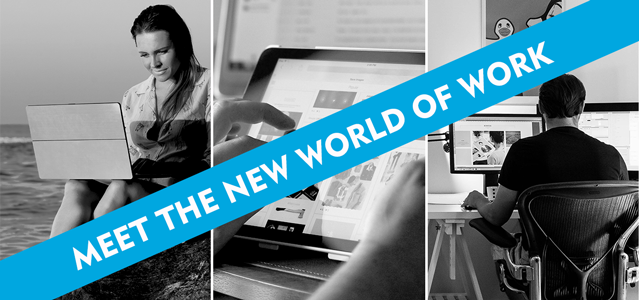Meet the New World of Work (Your Employees and Customers Will Thank You)
Work happens. Whenever and wherever, by people using technologies that make locations irrelevant and time zones an afterthought. Teams become an agile mix of resources, scaling up and down as projects demand. Welcome to the new world of work.
In honor of National Flex Day on October 17, we invite you to take a closer look at the changing workplace with us. There’s a lot more to it than just working from home in your shorts and flip flops (though we don’t mind that perk at all).
Team Lightspeed lives the new world of work every day, and we wouldn’t have it any other way.
From creativity to productivity to the customer experience, here’s why the future’s so bright we gotta wear shades. Um, while working from the beach.
![]()
Happy employees, happy customers – and an end to TPS reports
There was a time when employees spent their days in grey cubicles, doing Totally Pointless Stuff for micromanaging bosses. Oh wait, that was the movie Office Space. It seemed so real.
Flexible working policies in today’s world of work allow employees to vary their hours and use the latest technologies to work from home or on the move. According to a Vodafone survey of 8,000 employers and employees across 10 countries, 75% of companies have introduced such policies. Among the businesses that have already adopted flexible working, the Vodafone survey found:
83% reported improvements in productivity, 61% reported increased profitability and 58% reported a positive shift in their company’s reputation.
When you get flexy to improve your employees’ experience, your customers also benefit.
Forrester Consulting’s report, The Worker Shapes The Customers’ Experience, found “a ubiquitous consensus” among business leaders that a good worker experience engages workers to provide a better customer experience, ultimately affecting their organization’s bottom line. The report says:
Customer experiences aren’t created in a vacuum — they are the product of workers’ tireless efforts. …To ensure these workers can design, deliver, and support high-quality experiences, companies must build corporate infrastructure that fosters worker productivity, engagement, and agility.”
![]()
Rise of the blended workforce
Who are these tireless workers? The Forrester report says they’re anyone who represents your brand. Full-time and part-time employees, contingent workers, contractors, business vendors/partners and freelancers are all part of today’s project teams.
In Forbes’ 10 Workplace Trends You’ll See In 2017, Research Director Dan Schawbel of Future Workplace notes employers benefit from the blended workforce with more flexible teaming, adding:
In the past five years, the gig economy has become a major trend impacting the global workforce, and has created a new kind of diversity, with full-time permanent employees working side-by-side with freelancers.”
Stephane Kasriel, CEO at Upwork and co-chair of the World Economic Forum Global Future Council on Education, Gender and Work, says smart companies are outsourcing work to qualified talent wherever they live. He adds:
People want freedom and flexibility. They want to be in charge of their own destiny. Managers need to prepare for this. …More and more we’re going to see people working with flexible hours from a distance.”
![]()
Creativity and innovation flourish in a flexible workplace
When we’re free to work and collaborate when, where and how we choose, good stuff happens – and new skills take precedence.
Future of Work expert and author Cheryl Cran says creativity, constant learning and the ability to be self-directed are all key employee skills valued in the future-focused organization. Yes, yes and yes.
Creativity: A good brainstorm breaks past the “been there, done that,” while a bad one can stifle creativity. Team Lightspeed thanks TV comedy writer James Mulvey for telling marketers what we were getting wrong about our brainstorms.
Inspired by Mulvey’s formula, we share the craziest ideas we can think of in the initial brainstorming session for each new project. Then we scale down from there. By contributing, listening and building on each other’s ideas, everyone stays engaged.
A wild idea can become a crazy-good idea through this collaborative group thinking.
Constant learning: For resources and tips, we’ve got you covered. See our blog: Call Yourself a Modern Marketer? Use These Learning Tips to Go Back to School All Year.
Ability to be self-directed: Team Lightspeed is a blend of full-time employees and contractors who work closely with business partners and freelancers. We’re spread across time zones, with members who call Raleigh, Chicago and San Francisco home. Each person has a unique set of talents and is fully responsible for staying accountable and engaged.
![]()
Communicate, collaborate and celebrate
In a flexible work environment, teams need accountability and trust to deliver the best customer experience possible. Sound easier said than done?
If Team Lightspeed can do it, so can you. On any given day, our workplaces include our homes, customer event locations around the world or HQ Raleigh, a co-working space for mobile entrepreneurs.
Our members stay connected using a balance of process, flexibility, technology and yes, meetings.
Everyone has an opinion about how to Stop the Meeting Madness. What works for us is to meet as a team twice a week and stay within a 15- to 60-minute range – just enough time to touch base and share relevant updates.
We make our annual planning part of “Celebration of Lightspeed Week,” which coincides with our entire team attending the Internet Summit in Raleigh in November.
The week also includes our borderline legendary Lightspeed cookout, where family members join to sample Brent’s fried turkey and transition into the Thanksgiving holidays.
![]()
Technology gives us countless ways to make it work
All that communicating and collaborating in the new world of work couldn’t happen without technology.
Naomi Titleman Colla, founder of Collaborativity Leadership Advisory and former Chief HR Officer of American Express Canada, agrees today’s workers don’t need to be in the same office, time zone or country to complete work effectively. She says:
The good news is, thanks to the exponential acceleration of technology coupled with demographic and other economic shifts, there are countless ways to get work done.”
At Lightspeed we use a variety of technologies, including meeting over video (Cisco WebEx), instantly chatting (Slack), sharing files virtually (DropBox), managing projects with a mobile app (Asana), and jotting down ideas anywhere a sudden lightbulb moment hits (Evernote).
Just don’t be surprised if technology bites you in the ass from time to time.
Our Communications and Social Media Director Brent Brandow had a Professor Robert Kelly moment on one of our team video calls, only it wasn’t his kids who crashed the meeting. It was his visiting mom. Brent says,
You never know what’s going to happen. There are still a few holdouts like my Mom who don’t think working from home is a thing. But she did enjoy waving at my teammates on camera. Especially at Billy (Matiernan).”
Technology leaders are going beyond today’s advances to picture and create the Future of Work. Cisco’s comic-book blog series, To Save Tomorrow, envisions what the workplaces of the future will be like in 10 or 20 years. The series explores areas ripe for innovation including robotics, artificial intelligence and virtual reality. All have emerged from the pages of science fiction to the new world of work.
Kate O’Keefe, senior director of Cisco Hyperinnovation Living Labs, says:
Will there be uncertainties as humans and machines evolve together? Of course. In fact, one reason we’re doing this comic book series is to help us think in a concrete way about potential pitfalls. By envisioning various versions of the future, we can help create the future we want.”
![]()
Future-proof your business
Future-proofing your business means re-thinking your talent strategy and how flexible your approach to work is now. Colla of the Collaborativity Leadership Advisory breaks down the basics for the new world of work into five questions:
- Why should I do work any differently?
- What is the work that needs to be done differently?
- Who is the best candidate to do the work?
- How should the work get done?
- When and where should the work get done?
- All great questions, and we’ll add one more:
- How do you scale to meet the changing needs of your customers?
For more about our approach to the new world of work, read What We Do.






